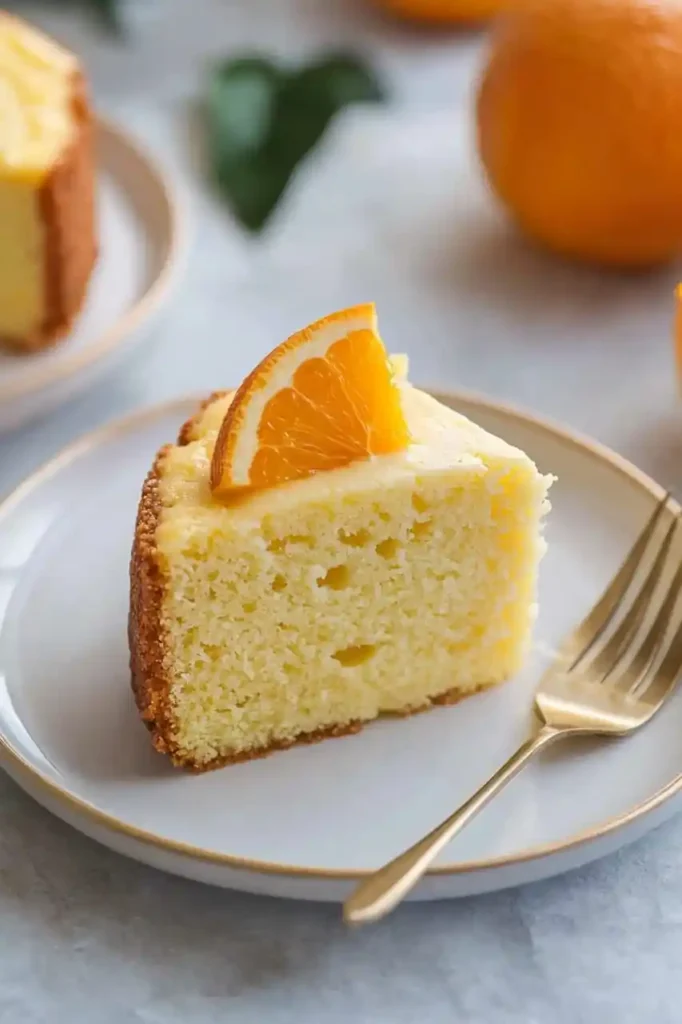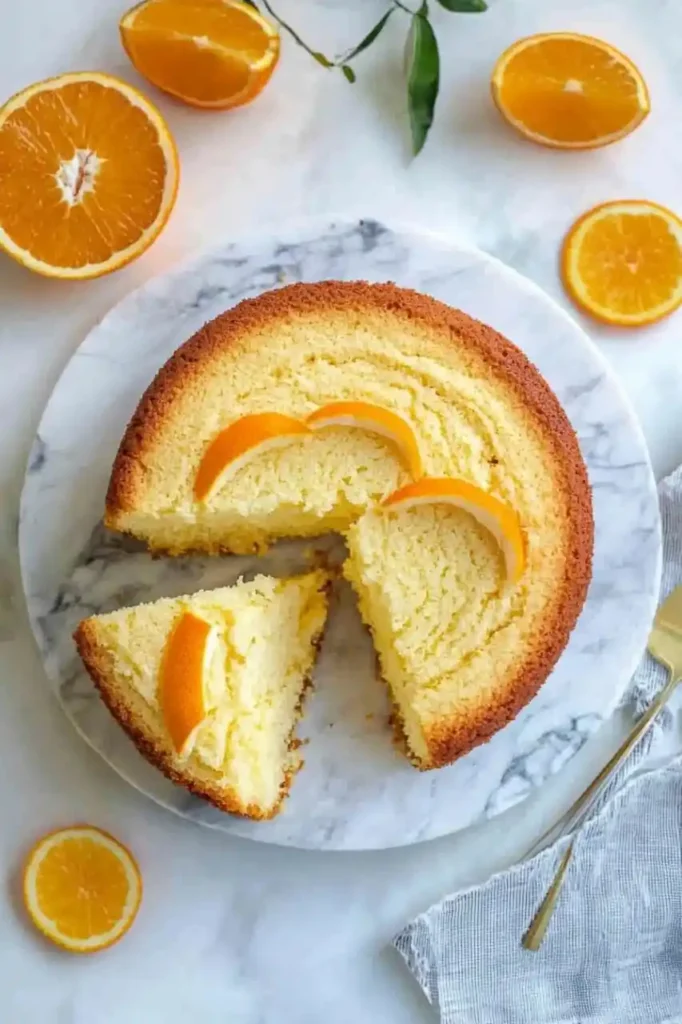This cake is made with fresh orange juice, zest, and a sweet glaze that perfectly ties everything together. Throughout the summer, I tried and shared many delicious cakes with you, and if you’ve been following me, you’re probably familiar with them! But when winter rolls around, I often crave spicy food. Yet, after a fiery meal, we sometimes need something sweet to balance the flavors. That’s exactly why I decided to try this cake—it’s the perfect winter treat to satisfy that craving. Don’t worry, it’s simple to make, and I’m sure you’ll love it as much as I do.

Ingredients
For the Cake:
- All-purpose flour
- Baking powder
- Baking soda
- Salt
- Unsalted butter (softened)
- Granulated sugar
- Eggs
- Vanilla extract
- Orange zest (from about 1 orange)
- Fresh orange juice (from about 2-3 oranges)
- Buttermilk (or substitute with milk and lemon juice)
For the Orange Glaze:
- Powdered sugar (confectioners’ sugar)
- Fresh orange juice
- Orange zest (optional for extra flavor)
How To Make Old Fashioned Orange Juice Cake
1. Prepare the Oven and Cake Pan
- Begin by preheating your oven to 350°F (175°C). Preheating ensures that the oven is at the right temperature when the batter is ready, allowing for even baking.
- For the cake pan, grease it with butter or oil and flour it lightly, or you can use parchment paper. Greasing and flouring the pan prevents the cake from sticking and ensures it comes out easily after baking. If using a bundt pan, make sure you grease all the crevices for smooth release.
2. Mix the Dry Ingredients
- In a medium-sized bowl, whisk together the dry ingredients: all-purpose flour, baking powder, baking soda, and salt. This step helps evenly distribute the leavening agents and salt, preventing clumps and ensuring consistent rise throughout the cake. Set the bowl aside as you move on to the next steps.
3. Cream the Butter and Sugar
- In a large mixing bowl, beat the softened butter and granulated sugar together using an electric mixer or stand mixer. Start on low speed to avoid sugar flying out of the bowl, and gradually increase to medium speed. Beat for about 2-3 minutes until the mixture becomes light and fluffy. This process, known as “creaming,” helps incorporate air into the mixture, which contributes to a light, soft texture in the cake. The butter and sugar should appear pale and smooth when properly creamed.
4. Add Eggs and Flavorings
- Add the eggs one at a time, making sure to beat well after each addition. This ensures the eggs are fully incorporated and emulsify the butter and sugar mixture, giving the cake a smooth texture.
- After all the eggs are mixed in, add the vanilla extract and orange zest, which will contribute to the flavor profile of the cake. Mix these ingredients in until they’re just incorporated into the batter.
5. Alternate Adding Dry Ingredients and Wet Ingredients
- Now, it’s time to combine the wet and dry ingredients. Lower the mixer speed to low to prevent flour from spilling out.
- Alternate adding the dry ingredients (flour mixture) and wet ingredients (orange juice and buttermilk) to the batter in three parts. Begin and end with the dry ingredients. Add the flour mixture, then follow with the wet ingredients, and repeat until all ingredients are mixed in. Each time, mix until just combined. Be careful not to overmix, as this can result in a dense cake. Overmixing can develop the gluten in the flour too much, causing a less tender crumb.
6. Pour the Batter into the Pan
- Once the batter is fully combined, pour it into the prepared cake pan. Use a spatula to spread the batter evenly across the pan. Make sure it is smooth and level on top to ensure the cake bakes evenly. This will help the cake rise uniformly and avoid uneven texture or height.
7. Bake the Cake
- Place the pan in the preheated oven and bake for 30-40 minutes. Baking time can vary slightly depending on your oven, so it’s important to check for doneness. You can test if the cake is ready by inserting a toothpick into the center of the cake—if it comes out clean or with a few moist crumbs, it’s done. The top should be golden brown. If the cake is browning too quickly on top, you can cover it loosely with foil and continue baking.
8. Cool the Cake
- After baking, let the cake cool in the pan for 10-15 minutes. This allows the cake to firm up slightly and makes it easier to remove from the pan without breaking.
- After that, invert the pan to release the cake, and carefully transfer it to a wire rack to cool completely. Cooling on a wire rack allows air to circulate around the cake, preventing it from becoming soggy on the bottom.
9. Prepare the Orange Glaze
- While the cake is cooling, you can prepare the orange glaze. In a small bowl, whisk together the powdered sugar, fresh orange juice, and optional orange zest until smooth. The glaze should have a pourable consistency, but not too runny. If it’s too thick, you can add a little more orange juice to thin it out. If it’s too thin, add a little more powdered sugar to thicken it up.
10. Glaze the Cake
- Once the cake has cooled completely, pour the glaze over the top of the cake. If you’re using a bundt pan, you can allow the glaze to drip down the sides, creating a beautiful effect.
- For a more controlled application, you can drizzle the glaze over the cake with a spoon or drizzle bottle.

Pro Tips
- Use Fresh Orange Juice: For the best flavor, always use fresh orange juice rather than store-bought. The fresh zest will also elevate the citrus flavor in both the cake and glaze.
- Check for Doneness: Cake baking times can vary depending on your oven and pan type. Use a toothpick or cake tester to ensure the cake is fully baked.
- Don’t Overmix the Batter: Overmixing can lead to a dense cake. Mix until just combined for the lightest, fluffiest texture.
- Butter vs. Oil: You can substitute butter with vegetable oil for a slightly different texture. However, butter provides more flavor and richness.
How to Store Leftovers
- Room Temperature: If you have leftovers, store the cake in an airtight container at room temperature for up to 2-3 days. It should stay fresh and moist.
- Refrigeration: For longer storage, you can keep the cake in the refrigerator for up to a week. Be sure to cover it tightly with plastic wrap or store it in an airtight container.
- Freezing: If you want to store the cake for an extended period, you can freeze it. Wrap the cake tightly in plastic wrap, then in aluminum foil or a freezer-safe bag. It can be frozen for up to 3 months. Thaw the cake at room temperature before glazing and serving.

Serving Suggestions
- Serve this Old Fashioned Orange Juice Cake with a cup of tea or coffee for an afternoon treat.
- Top the cake with whipped cream or a dollop of vanilla ice cream for an extra indulgent dessert.
- Add some fresh orange slices or mint leaves as garnish for an elegant touch.
Enjoy this Old Fashioned Orange Cake with Orange Juice as a sweet, citrusy treat that’s perfect for any time of the year!
More Cake Recipes
- Strawberry Pound Cake
- Coconut Pound Cake
- Lemon Blueberry Pound Cake
- Lemon Pound Cake
- Red Velvet Cake
- Chocolate Cake
Old Fashioned Orange Juice Cake
Ingredients
For the Cake:
- 2 cups all-purpose flour
- 1 ½ teaspoons baking powder
- ¼ teaspoon baking soda
- ½ teaspoon salt
- ½ cup unsalted butter softened
- 1 cup granulated sugar
- 2 large eggs
- 1 teaspoon vanilla extract
- 1 tablespoon orange zest from about 1 orange
- ¾ cup fresh orange juice from about 2-3 oranges
- ½ cup buttermilk or substitute with ½ cup milk + 1 tablespoon lemon juice
For the Orange Glaze:
- 1 cup powdered sugar confectioners’ sugar
- 2 tablespoons fresh orange juice
- 1 teaspoon orange zest optional for extra flavor
Instructions
Prepare the Oven and Cake Pan
- Preheat your oven to 350°F (175°C). Grease and flour a 9-inch round cake pan or a bundt pan, or line it with parchment paper to prevent the cake from sticking.
Mix the Dry Ingredients
- In a medium bowl, whisk together the flour, baking powder, baking soda, and salt. Set aside.
Cream the Butter and Sugar
- In a large mixing bowl, beat the softened butter and granulated sugar together using an electric mixer or stand mixer. Start at low speed, then gradually increase to medium speed, and mix for 2-3 minutes, or until the mixture is light and fluffy.
Add Eggs and Flavorings
- Add the eggs one at a time, beating well after each addition. Add the vanilla extract and orange zest, mixing until incorporated.
Alternate Adding Dry Ingredients and Wet Ingredients
- With the mixer on low speed, alternate adding the dry ingredients (flour mixture) and wet ingredients (orange juice and buttermilk) in three parts. Start and end with the dry ingredients. Mix each addition until just combined, being careful not to overmix.
Pour the Batter into the Pan
- Pour the batter into the prepared cake pan and spread it evenly.
Bake the Cake
- Bake the cake in the preheated oven for about 30-40 minutes, or until a toothpick inserted into the center comes out clean, and the cake is golden brown on top. Keep an eye on it, as oven temperatures can vary.
Cool the Cake
- Allow the cake to cool in the pan for 10-15 minutes, then carefully remove it from the pan and transfer it to a wire rack to cool completely.
Prepare the Orange Glaze
- While the cake is cooling, prepare the glaze. In a small bowl, whisk together the powdered sugar, fresh orange juice, and optional orange zest until smooth and free of lumps. Adjust the consistency by adding more juice or powdered sugar as needed.
Glaze the Cake
- Once the cake has cooled, pour the glaze over the top. If using a bundt pan, allow the glaze to drip down the sides for a beautiful presentation.
Notes
- Use Fresh Orange Juice: For the best flavor, always use fresh orange juice rather than store-bought. The fresh zest will also elevate the citrus flavor in both the cake and glaze.
- Check for Doneness: Cake baking times can vary depending on your oven and pan type. Use a toothpick or cake tester to ensure the cake is fully baked.
- Don’t Overmix the Batter: Overmixing can lead to a dense cake. Mix until just combined for the lightest, fluffiest texture.
- Butter vs. Oil: You can substitute butter with vegetable oil for a slightly different texture. However, butter provides more flavor and richness.

